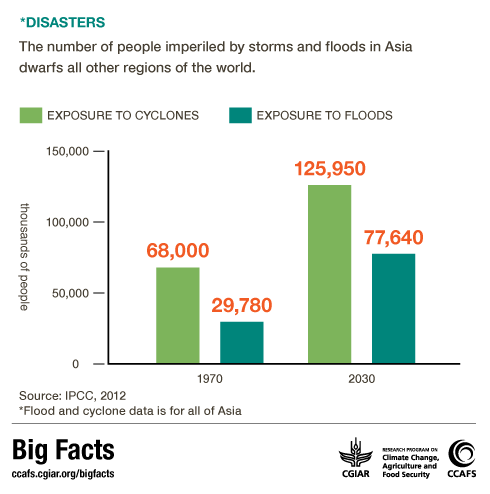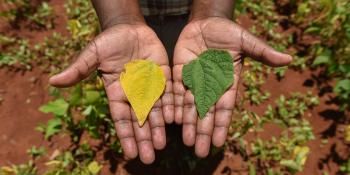What does the future hold for Bangladesh? Modeling scenarios for better climate policies

Future Scenarios hit a high-level policy note in Bangladesh's Planning Commission as it considers using scenario development and modeling in 5 Year Government Plan.
Both the World Bank and the IPCC have declared Bangladesh as one of the most climate-vulnerable countries in the world in dire need of support and adaptation.
And as floods, tropical cyclones, storm surges and droughts start to become normal incidences for the country, the government is  trying its best to prepare and protect its population.
trying its best to prepare and protect its population.
But how does a country, with few resources and own governance challenges, best manage a climate that is rapidly changing?
One way to power through is to establish and implement forward-looking, flexible policies that take uncertainty, and current climate knowledge into account.
This is exactly what the CGIAR Research Program on Climate Change, Agriculture and Food Security (CCAFS) Future Scenarios research team aims to achieve - more robust climate policies through modeling and scenario building with key, influential, local stakeholders across the program’s five regions.
Scenarios work reach Bangladesh
The regional South Asia Future Scenarios team has throughout the year established a partnership with the Bangladesh Planning Commission and the International Centre for Climate Change and Development (ICCCAD). A few months ago a two-day workshop was held in Dhaka to test the robustness of the 7th 5 Year Plan for the Government of Bangladesh through future socio-economic scenarios combined with climate impacts on agriculture.
The 5 Year Plan, prepared by the Ministry of Planning, follows a structured and flexible framework that helps the country stay on track of economic and social development policies and goals. Working together with the Scenarios team meant the Commission was open to generate new ideas and content for the upcoming Plan based on the challenges offered by the scenarios.
We started off by downscaling and developing detailed scenarios for Bangladesh from the existing South Asian scenarios. The participants really felt these were useful as they helped them visualize what the future might hold for their country," says Maliha Muzammil, South Asia Regional Scenarios Coordinator, based at the University of Oxford.
The downscaled, scenarios that were developed, with results from the advanced modeling programs GLOBIOM and IMPACT, were then used to broaden the scope and test the feasibility of the Planning Commission’s ideas for the Plan and make them more robust, flexible and concrete," says Maliha Muzammil, who also organized the workshop.
Photo by Syed Tasfiq Mahmood (UNCCCD) from the Bangladesh workshop earlier this year. View more photos here.
What does the future look like in Bangladesh in 2050?
Four future scenarios for the country were outlined, both positive, prosperous, scenarios along with really disastrous ones. Stakeholders spent considerate time to create narratives for the various modeled scenarios, like the below ones:
Bangladesh as a role model for development
In this scenario, by 2050, after a long and difficult time of structural reforms, democratic and efficient governance systems are in place. The systems are climate inclusive, promote bottom-up and participatory approaches and the rule of law is upheld and followed. The industry and service sector are dominant in Bangladesh: there are high private sector investments and the government acts as a facilitator. Good regional trade relations are established, and good infrastructure, technical knowledge and research facilitates are in place to continue sustainable development.
Impact pathways to achieve key objectives and strengthen the desirable drivers of this scenario: Digitization of governance, taxation and information systems; Micro-climatic zone specific vulnerability assessment and ADMIT interventions; Plans and policies that are adaptive to changing situations and incorporate the voice of vulnerable groups, following a bottom-up and participatory approach.
Living in a nightmare
In this scenario, high population growth and urban expansion contributed to crises in energy, water and sanitation. Extreme climate events together with sea level rise hit Bangladesh sooner than expected, and with an unexpected magnitude, forcing millions to flee the coastal areas. Due to low level of state coverage of health care, and highly corrupted state services, Bangladesh sees private clinics boom, and also a growth in security services that can be only afforded by “privileged” groups. These privileged groups control all natural resources and dominate business. The gap between the rich and the poor is getting larger over the years.
Impact pathways; or HOW to AVOID the NIGHTMARE: A strong focus on fair land use planning through better monitoring and evaluation tools, as well as fairer conduct within civil service, avoiding corruption by raising normal pay and other means. Decentralization to be invested in, not only in terms of power but also population redistribution. Climate change: building institutional adaptation mechanisms to reduce loss and damage due to natural disasters, providing relevant and timely support.
From scenario development to policy change
The workshop was really fruitful as commissioners and other stakeholders could discuss plausible futures, and which impact pathways to take in order to get there, or how NOT to get there. Having that visualization of different future scenarios under various conditions, can really help make for good policies today," says Maliha Muzammil.
The Planning Commission hopes to implement the major systemic interventions and suggested improvements that came out of the workshop into the 5 Year Plan, which is to be released next year. In partnership with ICCCAD, Maliha recently presented the workshop outputs to a wider audience in early December at their Learning Hub event, where members from the Planning Commission, Ministry of Finance, Ministry of Environment and Forest and other international and multilateral organizations were present.
Other outcomes from the workshop include establishing a long term partnership with the Planning Commission and the Scenarios Team. The ambition is to organize a follow up workshop early next year to help assess the actual draft of the plan.
The workshop also served as a successful introduction to scenarios planning for the Commission members, and built further capacity to use scenarios for such purposes. In addition, the stakeholders are also considering using the down-scaled South Asia scenarios and the Scenario process in the upcoming National Adaptation Plan (NAP) which is now being prepared.
These type of opportunities and results are only possible when you work face to face with policy makers, building a level of trust, and making sure there is support throughout the process; from developing scenarios to implement suggested improvements and changes into high-level strategies and plans," says Joost Vervoort, Scenarios Officer for CCAFS Future Scenarios working at Oxford University.
Learn more about our Future Scenarios work:
- Putting policies to the test: scenarios on food security, environments and adaptation
- Future scenario development now part of Cambodia's Action Plan for Agriculture
Written by Cecilia Schubert Communications Officer at CCAFS with significant contributions from Maliha Muzammil and Joost Vervoort, both working for the Future Scenarios team




